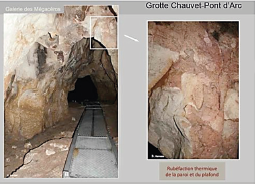31/5/2016
Efectis is participating in the collaborative research project CarMoThaP (Characterization and Modelling of Thermal alterations and combustion residues on walls), which is supported by Aquitaine regional council and brings together 34 researchers from eleven partners.

This project (2015-2018) aims to simulate fires in complex cavities such as Paleolithic caves, taking into account fuel characteristics and ventilation conditions. These calculations will allow evaluation of the conditions in which thermal alterations of limestone (e.g. reddening and peeling) and carbonaceous deposits (soot, char, etc.) occurred, as observed in caves such as Chauvet. Determination of smoke propagation in the cavity and tenability conditions in terms of toxicity and temperature will also be investigated.
As part of this project, several types of fire (different fuel supply methods and storage arrangements), representative of fires employed in Paleolithic caves, will be reproduced experimentally.
Combination of indoor and outdoor fire tests with simulation will address archaeological and actual issues, assessing the ambient conditions (e.g. temperature and toxicity) and thermal loads (such as heat flux), imparted to cave walls. This will make it possible to understand the types and functions of cave fires, and also to identify the thermal process that causes alterations of limestone walls.A physical-chemical database for carbonaceous residues (soot and char) will be created and will provide information on the nature of the fuel (wood) and its combustion conditions.

Thermo-alterations (reddening, peeling) at vault of Chauvet cave
Contact: Virginie Drean – virginie.drean@efectis.com

